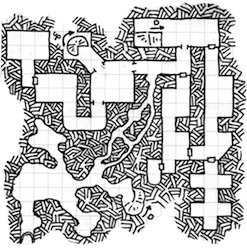

This mostly affects your map layer so be sure to set it before you start building everything else, the system can start to lag if you have a complex map thats over 40x40.įog of War drops a total (light is blocked too) screen over the page. Page size is just the tile width and height of your overall map, with each tile representing 5ft. In the blue Pages tab, click the gear on a page. They’ll appear in your My Library and you can sort them from there. Take images from your computer and drop em’ into the game. It otherwise functions like the GM layer, tokens are hidden but any lighting settings are visible. It’s a bit janky in it’s implementation, but critical if you’re hoping to reveal parts of a map without giving anything away. The dynamic lighting layer is where you set up light sources in conjunction with the individual token and overall page settings. Use it for enemy reinforcements, or making items in the token layer appear and disappear. The GM layer is hidden to players and serves as a place to stash tokens or any other components. Some nonconventional pieces, such as a house roof, could be a token - it covers the interior on the map layer below until you move it out of the way for players to enter. The token layer is where players, enemies, and anything that could be moved around goes. Basically, anything you don’t want to accidentally click on while playing should go here.

This can also include tabletop items and decorative clutter. Generally, these are large tiles and shapes you don’t intend to move during regular play - the grass under players, the trees, NPC houses and structures. The map layer is where you put the background. Start in the top left toolbar to choose your layer. Each page is split into different layers - like a Shrek. In the Roll20 GM console, you build these scenes, called pages, mostly from scratch but largely from pre-made assets. When the players are done, they can proceed to the next scene in a sort of linear progression.

All of this takes place in a single scene. There, they can talk with NPCs who provide context and clues, getting directions to their contact who gives the party their lead on where to go next. For example, players arriving in a town square might observe the wreckage following an attack from the monster they were called in to kill. Planning Your SessionĪfter you’ve outlined your story the locations, NPCs, conflicts and encounters, you have to concentrate the parts down into scenes.Ī scene is, generally speaking, the beat of story in the overall narrative of the session. *This doesn’t mean you can’t have story arcs, only that you need to give warning if your session is going to be a 2 part’er or more. Consumables, fashion items, and take-home oddities are OK. Low Magic Item World Avoid doling out items that affect long term gameplay mechanics and power scaling, eg.The NPCs Teodor, Rose, and Belsar as well as the HQ grounds may not be used or altered as part of a session’s story unless approved beforehand. Ask the party before committing to multi-session games.* Sessions are self contained adventures with the goal stated at the beginning. As such, there are a few fundamentals to the campaign that are more or less hard set, unless negotiated prior to play. This guide is framed within the context of the ongoing campaign, The Interplanar Agency. Here we’ll focus on the general outline of session construction within the platform, with specifics on the nuts and bolts of game assembly in Roll20.

With a few successful 4+ hour Roll20 sessions under my belt, I’m ready to hand off the DM’s robe to others wanting to make their own games.


 0 kommentar(er)
0 kommentar(er)
